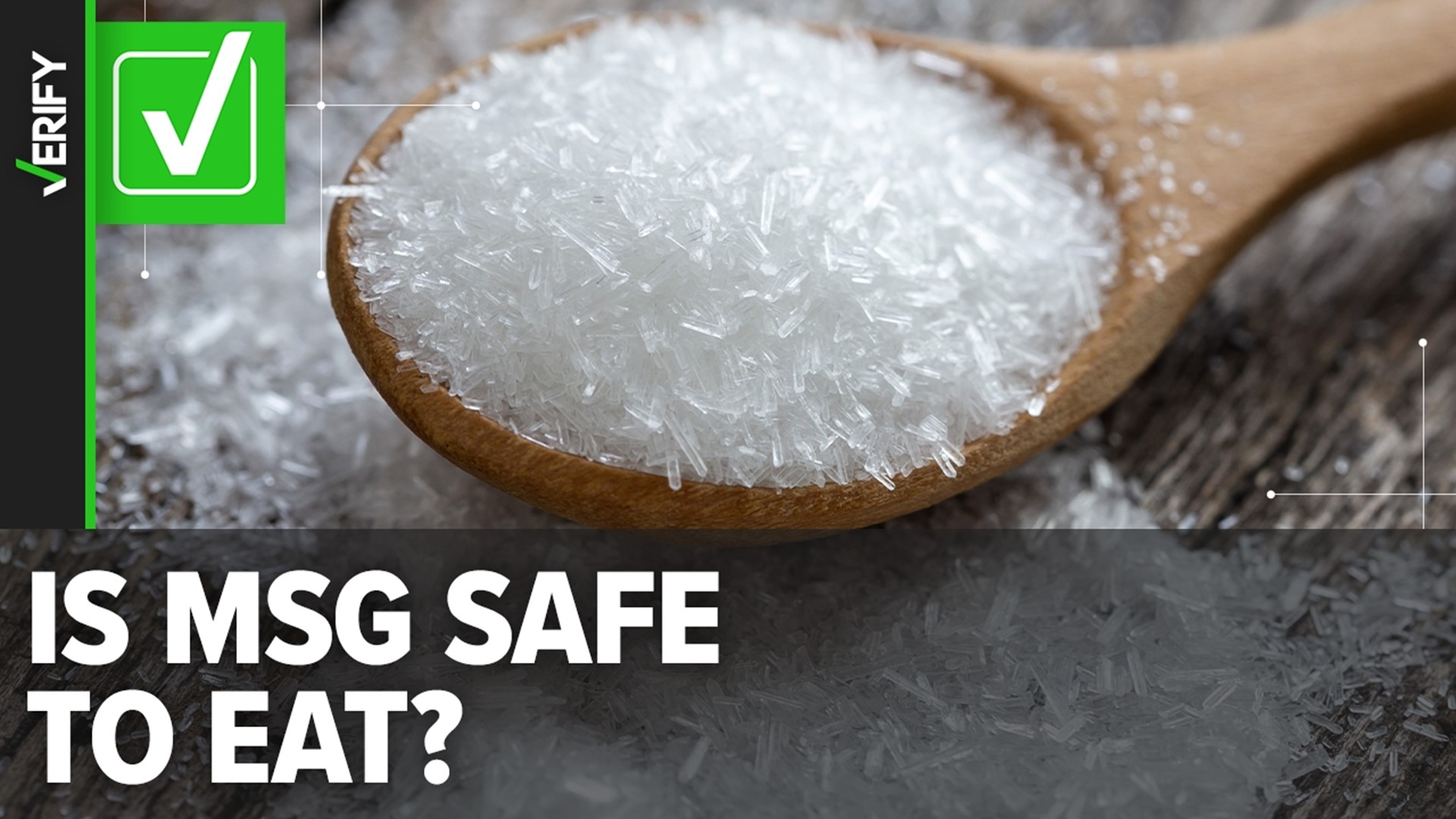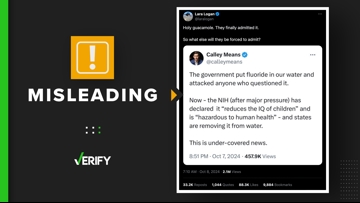Monosodium glutamate, known as MSG, is a flavor enhancer that consists of sodium, glutamate and water. MSG is typically produced “by the fermentation of starch, sugar beets, sugar cane or molasses,” the FDA says.
MSG is found in many processed foods, is commonly known for being used in Asian cuisines, and occurs naturally in some foods like tomatoes, legumes, mushrooms and seaweed, according to a University of Virginia Health article.
Its use as a flavor enhancer in food has been controversial since the 1960s, as some people reported that eating food with MSG caused symptoms such as headaches and heart palpitations.
Multiple readers, including Steven, told VERIFY they’ve seen contradicting information about the flavor enhancer and want to know about the safety of eating foods with MSG.
THE QUESTION
Is MSG safe to eat?
THE SOURCES
- Melissa Prest, a registered dietitian, nutritionist and spokesperson for the Academy of Nutrition and Dietetics
- A study published in the Journal of Allergy and Clinical Immunology
- A review published in Current Pain and Headache Reports
- A review published in Clinical & Experimental Allergy
- A review published in University of Southern California’s Gastronomica
- A review published in Food Science & Nutrition
- Food and Drug Administration
- Centers for Disease Control and Prevention
- Dietary Guidelines for Americans
- Cleveland Clinic
- A Mayo Clinic article
- A University of Virginia Health article
- A University Hospitals article
- The Harvard Crimson
- A Colgate University article
- A University of Washington Medicine article
THE ANSWER
Yes, MSG is safe to eat.
WHAT WE FOUND
National health organizations and experts agree that MSG is safe to consume as part of a balanced diet.
The FDA categorizes MSG to be “generally recognized as safe,” or GRAS. This means MSG is an FDA-approved food additive.
“For a substance to be GRAS, the scientific data and information about the use of a substance must be widely known and there must be a consensus among qualified experts that those data and information establish that the substance is safe under the conditions of its intended use,” the FDA says.
While the FDA says they have received reports of symptoms like headaches and nausea after eating food that had MSG, they “were never able to confirm that the MSG caused the reported effects” and “scientists have not been able to consistently trigger reactions.”
The FDA says studies found that mild symptoms, including headaches and numbness, occurred in people who consumed more than three grams of MSG without food, although most foods with MSG contain less than 0.5 grams of the substance.
Over the years, other studies have looked into the correlation between eating MSG and symptoms like headache, upset stomach and heart palpitations.
While some studies did not determine a correlation between experiencing symptoms and eating MSG, others found that it only occurred if MSG was consumed in excessive amounts.
A 1997 study published in the Journal of Allergy and Clinical Immunology determined a threshold for experiencing symptoms, such as headache, numbness and weakness, to be 2.5 grams.
A 2009 review of reports and studies about MSG published in the Clinical & Experimental Allergy journal could not find a correlation between MSG and the commonly reported symptoms, explaining that “despite concerns raised by early reports, decades of research have failed to demonstrate a clear and consistent relationship between MSG ingestion and the development of these conditions.”
A 2023 review of studies focused on the correlation of MSG and headaches published in the Current Pain and Headache Reports journal also looked at numerous studies involving MSG consumption and headaches. The review found that “none of the studies that had MSG administered with a meal reported a statistically significant difference in the incidence of headache.”
For the small number of people who may experience symptoms after consuming MSG, a Mayo Clinic article says “symptoms are often mild and don’t need to be treated.”
For people who need to reduce sodium intake, MSG is even sometimes recommended as an alternative to table salt.
Sodium is a mineral found in both MSG and table salt. But the difference is that “table salt is a mixture of sodium and chloride, and MSG is a sodium salt that contains an amino acid called L-glutamate,” Melissa Prest, a registered dietitian with the Academy of Nutrition and Dietetics, says.
Both MSG and table salt are used in similar ways in food, with MSG being more commonly used to season Asian dishes.
But there’s actually less sodium in MSG than there is in the commonly used table salt. MSG has “around 800 mg of sodium per teaspoon compared to 2,300 mg in a teaspoon of salt,” a University of Virginia Health article says.
“The benefit to MSG is that you can flavor your foods in a similar way to table salt but will consume less total sodium in that meal or recipe,” Prest adds.
A review published in Food Science & Nutrition says that replacing ½ teaspoon of salt with ½ teaspoon of MSG can lower sodium content by 37%.
Eating too much sodium is known to cause serious health problems, like heart disease and stroke.
The Centers for Disease Control and Prevention says on average “Americans consume more than 3,400 milligrams (mg) of sodium per day.” The current federal recommendation is to eat no more than 2,300 mg of sodium daily, according to the Dietary Guidelines for Americans.
“Research has shown that MSG is safe to consume,” Prest says. “Using sodium alternatives like MSG helps to reduce the amount of sodium in processed and ultra-processed foods while still retaining flavor.”
MSG is typically sold as a seasoning in the form of salt-like crystals in a shaker or bag. It’s often described as an “umami seasoning.” The FDA requires “that foods containing added MSG list it in the ingredient panel on the packaging as monosodium glutamate.”
SOURCE OF MISINFORMATION
Claims that MSG is unhealthy have been around since the 1960s.
A University of Washington Medicine article explains that “when MSG was first discovered, the U.S. was actively restricting how many Chinese immigrants came here,” and anti-Chinese racism was “rampant.”
In 1968, a letter was published in the New England Journal of Medicine titled “Chinese-Restaurant Syndrome.” The author of the letter described symptoms including numbness and palpitations after eating Chinese food. The author suggested that it was connected to MSG.
The original letter led to additional letters being sent in by physicians to the New England Journal of Medicine. Many of the “writers universally described experiencing symptoms after eating foods such as ‘egg foo yung’ or ‘duck sauce,’" a Colgate University article notes.
Although MSG is used in other cuisines and even found naturally in some foods, all of the early reports of symptoms sent to the journal about what’s now referred to as “MSG symptom complex” were directed toward Chinese restaurants at that time.
The letters and subsequent complaints and reports prompted laboratory studies and an FDA review of MSG, along with multiple other food additives in 1969, according to a Harvard Crimson article.
There was also a push at this time for MSG to be banned from baby food after John Olney, M.D., an assistant professor of psychiatry at the Washington University School of Medicine, found that mice experienced brain damage after being given MSG, the Harvard Crimson article explains.
Despite Olney’s testimony and multiple studies conducted in the 1970s, MSG “was never banned or subjected to further regulation,” a review of MSG history published in University of Southern California’s Gastronomica says.
Many of the baby food companies also criticized Olney’s study. Daniel F. Gerber, who was the chief executive officer of Gerber Products Company, “expressed doubt that monosodium glutamate had any potential harm for people, or that Dr. Olney's research was applicable to humans,” according to the Harvard Crimson.
The Gastronomica review adds that the FDA was also unable to draw a connection between MSG and any of the symptoms described as “Chinese-Restaurant Syndrome.”
A lot of early reports and studies in the 1960s that mentioned harmful MSG side effects were “flawed by methods, limited sample sizes and excessive intake of MSG,” according to a University Hospitals article.












